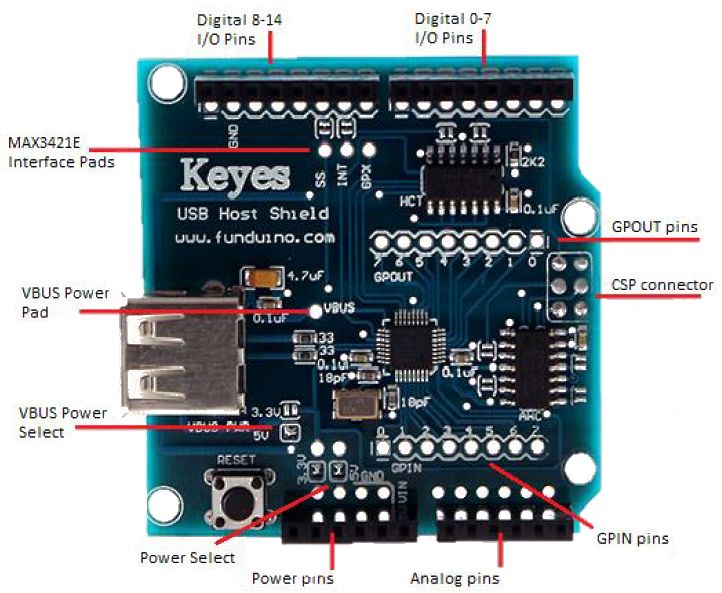
- #Arduino usb host shield pins how to
- #Arduino usb host shield pins pro
- #Arduino usb host shield pins software
Post navigation ← Controlling USB Missile Launchers using Arduino Let’s Build Robots at Foss. This entry was posted in Tutorials and tagged Arduino, Circuts home, Tutorials, USB Host shield on Octoby Sudar.
#Arduino usb host shield pins software
C Software support for new devices is constantly added at the moment, code for USB keyboard and PS3 controller are ready. This shield adds USB Host capabilities to popular Arduino platform. Try out the library and do let me know if you have any feedback or comments. The USB Host Shield contains all of the digital logic and analog circuit necessary to implement a full-speed USB peripheral/host controller with Arduino. Here I have connected 8 led’s to each of the GOut pins and I am controlling them separately. You can see the library in action in the below video. I have also created an example sketch which shows you how you can use this library to control the pins individually. So I immediately wrote an Arduino library, that abstracts out this bit manipulation and provides simple functions like write() and read(), that can be used to write or read from the pins individually. The bit manipulation that you have to do is not complex, but at the same time it is not as easy as doing digitalWrite() or digitalRead(). The problem with those two functions is that, you have to read or write all 8 pins at once, and then do some bit manipulation to control individual pins. I then checked the USB Host Shield library and found two methods, gpioRd() and gpioWr() that allows you to access these pins. I checked out the datasheet and found that these pins are controlled by the IOPINS1 and IOPINS1 registers (similar to the ports in AVR/Arduino). Accessing the GPIO pinsĪfter realizing about the GPIO pins, I immediately was trying to see if there is a way by which I can access them. The Max 3421 IC that is used inside the shield has 8 input and 8 output pins. In Arduino, the GPIO pins of the AVR micro-controller are mapped to the headers that are available on both sides of the board. These pins are know as GPIO (General Purpose Input and Output) pins.

GPIO PinsĮvery micro controller will have a set of pins that can be used for general input and output. If you are wondering what is an USB Host shield or what is USB Host mode, then do read my article about USB Host Shield and Arduino, which I wrote a couple of weeks ago. The USB Host Shield uses the Max 3421 IC to provide the USB Host capabilities for Arduino. In this tutorial, I will explain how you can access these GPIO pins of the Max 3421 IC which present in the shield. I realized when I had a closer look that the GPIO pins of the Max 3421 IC, present in the shield have separate headers and are not directly used by the shield. I was playing around with the shield by connecting a USB Missile Launcher and had a closer look at the shield. Both the hardware and the software of this shield are excellent and well written.
#Arduino usb host shield pins how to
Please also remember to visit the 'USB' category of our blog where we have posted many different guides and tutorials on how to use our contributions to the library, including PS3 controller, PS4 controller, Xbox controller and Bluetooth enabled devices (SPP, PS3, Wii, etc.One of my favorite Arduino shield is the USB Host Shield by circuits home. Remember to visit the blog with updates to the library, including new features and device classes: In the dropdown list below you can decide to get the board shipped with pre-cut matching headers.


This shield is shipped without headers by deafult.
#Arduino usb host shield pins pro
This shield only work with Arduino Pro Mini boards, running at 3.3V-only.ĭue to the small form factor and pinout, the board can also be used as a MAX3421E USB Host breakout board. And the board is of course compatible to the USB Host library that we have added a lot of features to, such as PS3 and PS4 controlling. The mini version makes it possible to add the USB Host functionality to Arduino Pro Mini projects by stacking the board on top of the Arduino. The USB Host Shield Mini from is a compact version of the well known USB Host Shield that we have been using for a lot of our USB Host development on the Arduino.


 0 kommentar(er)
0 kommentar(er)
